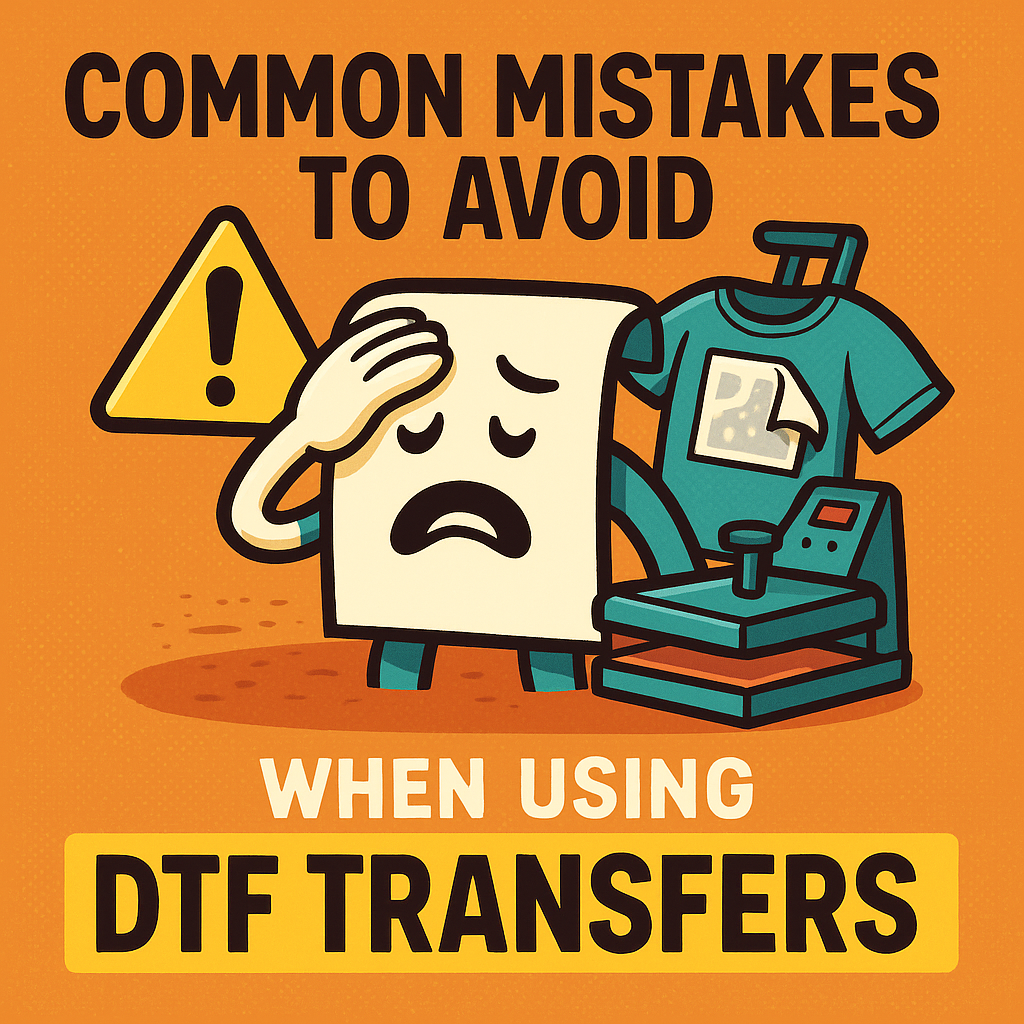
Common Mistakes to Avoid When Using DTF Transfers
Share
Direct-to-Film (DTF) transfers have revolutionized garment customization by offering durability, vibrant colors, and compatibility with a range of fabrics. However, just like any transfer method, DTF comes with its own learning curve. Whether you’re a beginner or an experienced professional, knowing the common pitfalls can save you time, money, and frustration.
This guide will walk you through the most frequent mistakes when using DTF transfers and provide actionable advice to get consistent, high-quality results. By avoiding these missteps and harnessing the power of quality supplies from Texas Transfers and Designs, you can elevate your projects and grow your printing business.
Mistake 1: Skipping Proper Garment Preparation
Why It’s a Problem:
Neglecting garment prep is one of the leading causes of poor adhesion and quality degradation. Dust, lint, and moisture can interfere with the transfer's ability to bond to the fabric, leaving you with uneven or peeling designs.
How to Avoid It:
- Preheat the Garment: Before applying the transfer, press your fabric with a heat press to eliminate moisture and wrinkles.
- Use a Lint Roller: Go over the substrate (garment or fabric) with a lint roller to remove any dust or debris. This step ensures a smooth, clean surface.
- Choose the Right Material: DTF is versatile, but ensure you’re working with compatible fabrics like cotton, polyester, or blends. Not sure which fabric works best? Browse our DTF-compatible products.
Proper prep ensures your design adheres flawlessly and remains vibrant over time.
Mistake 2: Using Incorrect Heat Press Settings
Why It’s a Problem:
Each DTF transfer requires specific temperature, pressure, and time settings. Using generic settings can lead to under-cured designs that peel or overcured transfers that lose their vibrancy.
How to Avoid It:
- Read the Instructions: Always refer to the instructions provided with your DTF transfers. These will specify the ideal temperature (typically around 325°F), pressure (medium to firm), and pressing time (12-15 seconds).
- Calibrate Your Heat Press: If your heat press isn’t heating evenly, it can cause uneven application. You can find reliable heat press supplies at Texas Transfers and Designs.
- Test on a Scrap: Before working on your final product, test the settings on a scrap piece of fabric. This can help you fine-tune the process.
Using the correct heat settings will prevent cracking, ensure proper adhesion, and keep colors vibrant.
Mistake 3: Misaligning the Transfer Design
Why It’s a Problem:
Proper alignment impacts the overall aesthetic of your project. A crooked or off-center design can ruin an otherwise perfect transfer.
How to Avoid It:
- Measure Before Placing: Use rulers or a T-square to find the center of your garment and ensure proper alignment.
- Secure the Transfer: Use heat-resistant tape to hold your transfer sheet in place. This prevents shifting during pressing.
- Practice Visualization: Before placing your transfer, visualize or use placement tools to see how it will look when applied.
Taking time to align the design not only saves transfers but also enhances the professional finish of your product.
Mistake 4: Peeling the Film Too Quickly—or Too Late
Why It’s a Problem:
Peeling the transfer at the wrong time can lead to incomplete adhesion or disrupt the design, especially if the transfer type requires a specific peeling method (hot or cold peel).
How to Avoid It:
- Understand the Transfer Type: DTF transfers are typically either hot peel or cold peel. Make sure you check the instructions for your specific product to confirm.
- Follow the Right Timing:
-
- Hot Peel: Remove the film while it’s still warm.
- Cold Peel: Allow the transfer to cool completely before peeling.
If peeling does not go smoothly, apply a top press using a silicone or parchment sheet to adhere the leftover areas.
For more troubleshooting tips on peeling, visit the FAQs on Texas Transfers and Designs.
Mistake 5: Overlooking Post-Application Pressing
Why It’s a Problem:
Skipping a final press can result in a transfer that lacks durability, leading to designs that crack or fade over time.
How to Avoid It:
After peeling, place a sheet of parchment or silicone paper over the design and apply a secondary press for 5-7 seconds. This optional step enhances durability and ensures the transfer bonds fully to the fabric for a professional finish.
Looking for essential tools? Explore high-quality heat press accessories at Texas Transfers and Designs.
Mistake 6: Ignoring Post-Application Care Instructions
Why It’s a Problem:
Even if applied correctly, improper washing and handling can shorten the lifespan of your transfer design.
How to Avoid It:
- Wait 24 Hours: Always wait at least 24 hours after application before washing.
- Wash Inside Out: Turn garments inside out to minimize friction on the design.
- Avoid Bleach and Harsh Detergents: Use mild detergents on a cold, gentle cycle.
- Air Dry When Possible: Skip the dryer or use a low-heat setting to prevent damage.
Encourage your customers to follow these instructions to keep their custom garments looking fresh.
Mistake 7: Using Poor-Quality Supplies
Why It’s a Problem:
The quality of your materials directly impacts the success of your projects. Low-quality transfer sheets, inappropriate fabrics, or a poorly functioning heat press can all diminish your results.
How to Avoid It:
- Source Reliable Transfers: Invest in premium-quality DTF transfer sheets, like those available at Texas Transfers and Designs.
- Maintain Your Heat Press: Clean and calibrate your heat press regularly for accurate performance.
- Choose Compatible Fabrics: Stick to materials that are proven to work seamlessly with DTF technology.
Using trusted supplies ensures a smoother application process and longer-lasting designs.
DTF transfers offer incredible potential when used correctly, but avoiding common mistakes is key to success. By prepping your garments, using appropriate heat press settings, and sourcing quality materials, you can create flawless designs every time. Stick to these best practices, and take your custom printing game to the next level.
For reliable DTF supplies, helpful resources, and expert advice, visit Texas Transfers and Designs. Their team is ready to support your business, ensuring every project is a success. Happy transferring!
